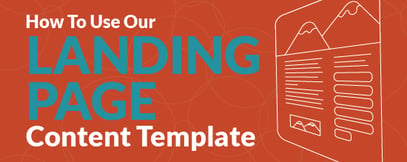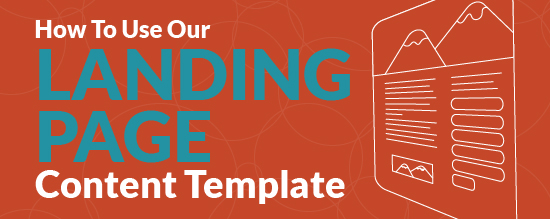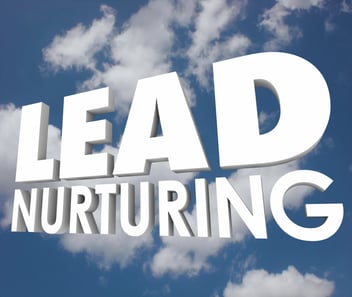How To Use Our Landing Page Content Template (free download)

Each year, we count down the 10 most-frequently downloaded assets in our Inbound Marketing Learning Library, and this template for organizing the content of website landing pages is always on the list (you’ll find it at #5 on 2020’s most-used marketing tools list).
The importance of landing pages is hard to overstate—after all, it is on these pages that website visitors turn into leads or contacts by completing a form to access some type of offer, whether that is a free trial, a blog subscription, a report of original research or a useable template like this one.
We have found that our readers love templates and checklists that help them do their jobs more effectively and save time creating forms and processes from scratch.
The Landing Page Content Template we offer as a free download on our website is a perfect example. It provides an effective way to organize each element on your website’s landing pages, ensuring they are consistent regardless of who on your staff is charged with creating them. While the original template is designed to reflect the elements in our own landing pages, you can modify it to fit your own standard landing page elements, which might include video or different buttons based on what the action is the visitor is taking (e.g. DOWNLOAD, JOIN, TRY NOW).
Before you start using the template to plan and organize your own landing pages, consider this:
Seven Basic Characteristics of Optimized Landing Pages
- Use a clear title, description, and layout to instantly convey the value of you roffer and create a strong incentive for your visitors to download or sign up for it.
- Keep your visitors focused on filling out your form by removing all distractions, including navigation links, from the landing pages.
- include social sharing links to encourage your visitors to spread the word about your offer.
- Design your forms to capture the information you need the most in order to follow up with and qualify the lead.
- Structure the forms with the user in mind so they're not too long or invasive.
- After they have filled out your form, follow up with your new leads by directing them to a "thank you" page or sending them an auto-response email. Keep them engaged by suggesting other offers they might be interested in or next steps they can take. (Ideally, you would enroll them in an automated lead nurturing workflow.)
- Track your conversion rates closely, and keep testing to find areas of improvement. Use your metrics and test results to optimize your landing pages so they continue to generate more leads.
Now, on the template itself, pictured below.
The template is a simple-to-use spreadsheet with 9 columns to organize all of the essential information. You can use the included text as a sample to get started, or change it up with formatting and word choices specific to your needs.
Column 1: Asset/offer
There are many different types of offers that use landing pages on business websites, from newsletter subscriptions and free trials to webinars, ebooks, case studies and more. The offer, and the target audience for that offer, will dictate how you craft the other pieces of the landing page. If the offer is aimed toward a specific buyer persona and level of the sales funnel (say, healthcare CFOs investigating and comparing billing software) you will want to focus the copy and images on your landing page toward the problems, questions and concerns of that group.
Column 2: Page heading
This is the first thing your landing page visitor is likely to notice. Keep it clear, concise and consistent with your calls-to-action. Visitors should be able to tell at a glance that they have arrived at the right place after clicking on a CTA in your blog, social media or other channel.
The main heading is also an important part of your on-page SEO. With its H1 formatting, it is an important part of how search algorithms determine the content of your webpage. Be sure to include the keywords or longtail phrases users might search when looking for something just like your offer.
Column 3: Subhead
A secondary heading provides the opportunity include additional detail or keywords, as well as stating the benefit the offer provides to your website visitor.
Column 4: Image
Using an image on a landing page adds visual interest to the page and can also reinforce that the visitor is finding what she is looking for. This could include showing the cover of a downloadable report, a key image (or even short video excerpt) of a webinar, or a photo of a product in use.
Make sure to provide alt text and use a descriptive file name (not just image1.jpg) to provide additional SEO power.
Column 5: Main text
In the main text of your landing page, you can provide more information about how this offer will benefit your prospective customer. Keep it to just a couple of sentences and don’t overdo the hyperbole. Sure, maybe it is amazing, fantastic and unmatched, but saying so makes skeptical readers think the opposite.
A bulleted list is a great way to tell visitors:
- What they will learn;
- What they can do;
- Or what makes this offer unique.
Column 6: Call-to-action
Your visitors clicked on a CTA to get to the landing page, but you will want to tell them again what they came to the page to do, and encourage them to do it. Add a quick exhortation to “Download,” “Request,” “Join,” or “Experience.”
Column 7: Heading above the form
As I mentioned, this template is created specifically to fit the format we use for landing pages on the JONES website for the assets offered through the Inbound Marketing Learning Library. Our page design includes another small heading directly above the form that visitors fill out in order to access the offer. Depending on your page design, you may or may not have a similar header, but if you do, consider it another opportunity to include benefits and action-oriented directives for the reader. Make this an action statement about what your customer can do with this offer, or what the offer will do for them.
Column 8: Form fields
Another key element on your landing page is the form your visitor will fill out. You may have different form fields for different offers, depending on the stage of the sales funnel being targeted.
Remember that top-of-the funnel offers should require only the very basic information needed. A blog subscription might ask for nothing more than an email address, not even a name.
You can ask for more information as a lead nears a purchasing decision. Those offers in the consideration and comparison stages may request complete contact information, including phone number, and information that helps build a more complete profile, such as company size, job title, or industry.
By using progressive forms, which automatically prefill information from leads who are already in your contact list, while asking them for a little more each time, you can develop helpful “lead intelligence” to pass on to sales without overwhelming and scaring off a new contact on their first visit to your website.
Column 9: URL
It can be helpful to plan and organize the URLs you will use for each landing page, both to create consistency that makes it easier for your staff and to ensure you are optimizing the URL for search. It may differ from the H1 heading to include slightly different keywords, but should be informative and concise (not “landing-page-22”).
What other columns would you find useful in planning, tracking and sharing information among team members about the landing pages you use in your inbound marketing campaigns? Feel free to make this template your own. You can download it here: Landing Page Content Template.
Landing pages are just one piece of complete integrated marketing campaigns that capture leads and nurture prospects through the sales journey. If you need additional guidance or assistance in developing full campaigns, from strategy through content creation and promotion, let’s talk about how JONES can help. Schedule a no-obligation consultation at the time that works for you here.
Keeping Up with Kristin
I enjoy traveling the globe to meet with clients, educate companies about all things PR and Inbound Marketing, and speak at industry events. Meet up with me when I’m in your city. Where will I be next?
Refer a Friend
Do you know a company that has the potential to become the envy of its industry? If so, refer your friends to us. If they join Jones, we’ll give you a $500 Visa gift card.
-1.png?width=1652&height=294&name=Jones(RGB)-1.png)













